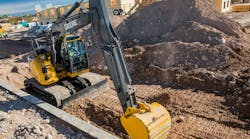This week, a 17-ton, 50-foot-wide electromagnet will be passing through our town on its way to Fermilab in Batavia, Ill. Two Interstate highways will be closed periodically over a three-day period so the magnet can be transported at 5 mph from the Illinois River to Batavia. The move will occur at night, and the magnet will stay in a Costco parking lot during one day and in a forest preserve a second.
Several aspects of this story fascinate me, including the fact that the journey started in Long Island more than a month ago. But I drive these Interstates regularly, and I walk daily in the forest preserve (it will be closed the day the magnet is there). The logistics of closing six-lane highways and storing a magnet down the road from my house are pivotal in accomplishing this move.
Logistics also are pivotal in equipment management. The fine art of moving iron affects job profitability and equipment utilization. The right machine has to be on the right job in time for the work to be done. That machine might be coming from another job or from the shop, but when the operator arrives to perform the task, it better be there.
Some companies, such as Cajun Constructors in Baton Rouge, La., create a separate transportation arm charged solely with maintaining a fleet of heavy trucks and haul trailers to move its equipment. With global companies such as Bechtel or Fluor, logistics requires overseas transport and the management of in-country land-based transport.
Emissions standards mandated by nonattainment areas require additional logistics management. Now fleet-asset managers need to plan not only how to transport a machine, but also which machine can work in what area of the region or country.
Those organizations with smaller, short-term projects often couple equipment transport with a dump truck or pickup truck. As simple as it sounds, the right machine must be on the right trailer connected to the right truck heading to the correct job.
Fleet-asset managers typically don’t have to worry about closing roads or parking machines in forest preserves. But this part of the equipment-management function is just as important as maintenance and acquisition. Failure to plan equipment transportation will torpedo utilization just as effectively as delayed maintenance.





